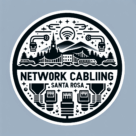How Significant Is Network Cable in the Community?
In today’s connected world, reliable communication is the backbone of every community — and network cables are what make that possible. From schools and hospitals to businesses and homes, network cabling plays a vital role in how people share information, access services, and stay connected.
Understanding the importance of network cables helps communities appreciate how these unseen systems power our daily lives, enabling everything from local government operations to neighborhood Wi-Fi. Our team of structured cabling professionals in Santa Rosa ensures that every installation supports reliable connectivity for homes and businesses.
What Is Network Cabling?
Network cabling refers to the physical wires and infrastructure that connect computers, devices, and systems to local networks or the internet. These cables — like CAT5e, CAT6, CAT6a, and fiber optics — transmit data quickly and securely between users and technology.
Without them, the internet connections, phone systems, and surveillance networks we rely on every day simply wouldn’t function.
Why Network Cables Are So Important in a Connected Community
Network cables may not be visible, but they serve as the foundation of modern communication. Here are a few reasons they’re so significant in the community:
1. Powering Local Businesses
Businesses rely on structured cabling systems for fast internet, secure data transfer, and efficient operations. Whether it’s a small shop running POS systems or a corporate office with multiple workstations, reliable cabling ensures uninterrupted service and productivity.
2. Supporting Education and Learning
Schools and universities depend on strong networks for online classes, digital tools, and administrative systems. Properly installed cabling allows students and teachers to access cloud-based learning, submit assignments, and collaborate in real time.
3. Enhancing Public Services
From police stations to city halls, network cables support essential community functions. Secure and dependable cabling ensures quick communication, data sharing, and emergency response coordination — keeping communities safe and efficient.
4. Connecting Homes and Families
Residential networks rely on structured cabling to deliver stable internet, smart home automation, and entertainment streaming. A strong network connection helps families stay in touch, work from home, and enjoy modern technology without interruptions.
5. Enabling Healthcare and Emergency Systems
Hospitals, clinics, and emergency services depend on fast, secure data connections to monitor patients, access medical records, and communicate with other facilities. Network cabling ensures that these systems function smoothly — often when seconds count the most.
The Role of Structured Cabling in Community Growth
Structured cabling isn’t just about connectivity — it’s about creating the foundation for economic and technological growth. A well-designed cabling system supports future technologies like 5G, IoT (Internet of Things), and smart city infrastructure.
For California and other tech-forward regions, structured cabling allows cities to grow sustainably while providing residents and businesses with cutting-edge digital services. It helps communities:
- Attract new businesses and investments
- Improve local internet coverage and reliability
- Enhance security through integrated surveillance systems
- Support sustainable smart-building technologies
Types of Network Cables Used in Communities
There are several kinds of cables that form the backbone of community networks:
- CAT5e: A cost-effective option for small networks and home use
- CAT6: Supports higher data speeds and is ideal for modern offices
- CAT6a: Offers even greater bandwidth and distance performance
- Fiber Optic: Provides the fastest speeds and is widely used for city-wide and enterprise-level networks
Choosing the right cable type depends on your community’s needs, infrastructure, and future plans. Among the various kinds of cables used today, it’s helpful to know the most common type of network cabling and why it’s preferred in most installations.
How Reliable Network Cabling Builds Stronger Communities
A strong network infrastructure has social and economic benefits that extend far beyond technology. It helps local governments operate more efficiently, enables schools to provide digital education, and allows healthcare providers to connect patients to care faster.
Reliable cabling systems empower communities to stay informed, safe, and connected — forming the foundation of a smarter, more connected society.
Why Professional Installation Matters
Professional network cabling installation ensures that systems are designed for maximum performance, safety, and scalability. Certified technicians follow standards like ANSI/TIA-568 and local building codes to ensure compliance and long-term reliability.
Professionally installed cables also reduce interference, improve signal strength, and make future upgrades simpler — saving both time and money for community projects and local organizations.
Conclusion
So, how significant is network cable in the community? In short, it’s essential. It powers communication, supports education and healthcare, strengthens businesses, and connects people across all walks of life. To fully understand its role in modern communication systems, learn about the primary function of network cabling in a network infrastructure.
Without reliable network cabling, communities would struggle to function efficiently in our digital age. Investing in structured cabling means investing in a stronger, smarter, and more connected future for everyone.
